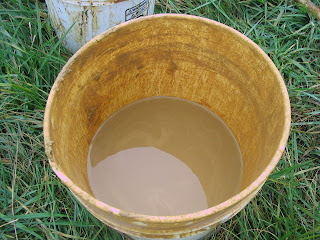
The person who built it only lived there for a season and never fully finished the house, but the important parts were there-- the framing and sheeting, windows, door, wiring for electricity, roof and gutters. The house was for sale but there weren't really any takers because the person buying it would have to become a member of Red Earth, or rather, a Red Earth member would have to be interested in the house for it to get sold. There was a deadline for the house to be sold or the owner would have to come and take it down. I thought it would be a shame for it to be torn down after such a short life and with DR needing housing I thought of the possibility of moving it over here. I thought I could live in it while I build my other house, then rent it out and DR would have another housing option.
It seemed like a small house, but it was hard to find someone who could move it. Finally, I did and now I'm waiting for them to set up a time to come and do it. I was originally planning to start insulating it and getting it ready for winter (it is not insulated and has no heating system) after it was moved here. Then the other night I was wondering why I had to wait. Since I have no exact date when the movers will get a chance to move the house, why not begin getting it ready for winter. With the days getting chillier all the time, I have no time to lose. So I've begun the insulation.
I thought about doing blown cellulose in the walls but wanted at least some part of the house to demonstrate natural building methods. At Red Earth there are no restrictions on using new lumber, so the house was built with all new lumber and OSB (oriented strand board). I'm keeping with the DR covenant on new lumber by recycling the entire house, but I decided to insulate with something called light clay straw, or light straw clay as some people call it. This is basically a mixture of clay slip (clay and water mixture) and straw.


Forms are nailed onto the studs to enclose the wall and the space is filled with this straw clay mixture. It is packed into all the corners.

After a section is filled the form can be immediately removed and the packed straw clay holds its shape. It is then allowed to dry in place and is later plastered over with earthen plaster.

This insulation has an R-value of at least 10 and the clay coating on the straw retards fire apparently (I still would like to test this sometime). Anyway, Brian, one of the newer DR residents is helping me out during October and we've been doing this project together. It's actually pretty fun to mix the straw and clay and pack it in the walls. So if we can make some serious progress on insulating, maybe by the time the house is moved, we can start the plastering. We'll see.

If you want to hear about another house here that was insulated with light clay straw, check out the DR video blog at drtv.dancingrabbit.org.
9 comments:
I am attempting to do something similar, using light clay straw to insulate my walls. Did you electrically wire your house and if so where did the wires go? Did they get covered by the light clay straw or did they run along the outside?
In response to Storms, though it's probably too late, the house was wired already with 12-2 wire. We just packed the light clay straw around the wire so the wiring is buried in the straw. I'm not sure how up to code this would be for most places. You might have to run conduit or something more insulated to meet code in other places. You could also run the wire under the plaster coat and on top of the straw.
Hey very nice blog!! Man .. Beautiful .. Amazing .. I will bookmark your blog and take the feeds also…
Hi, very interesting post, greetings from Greece!
awesome content!
Thanks for the info! We're making a custom pair of slippers for you :)” oh wow thank you!!
hey not sure if you are still working on this, i would like to know how it all turned out. also where did you get your R- value for the slip and how thick are the walls?
just wondering how your project went
hey delish farmgirl, don't know if you will ever check this, but the house is still doing well. they walls are 6" thick and I believe I'd calculated the R-value based on an estimate I'd heard for light clay straw. You can see later work on this house in later entries to the blog.
Post a Comment